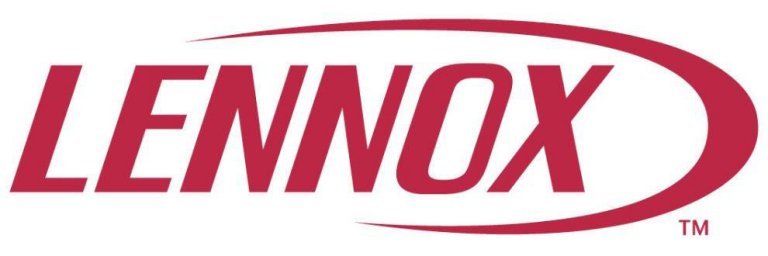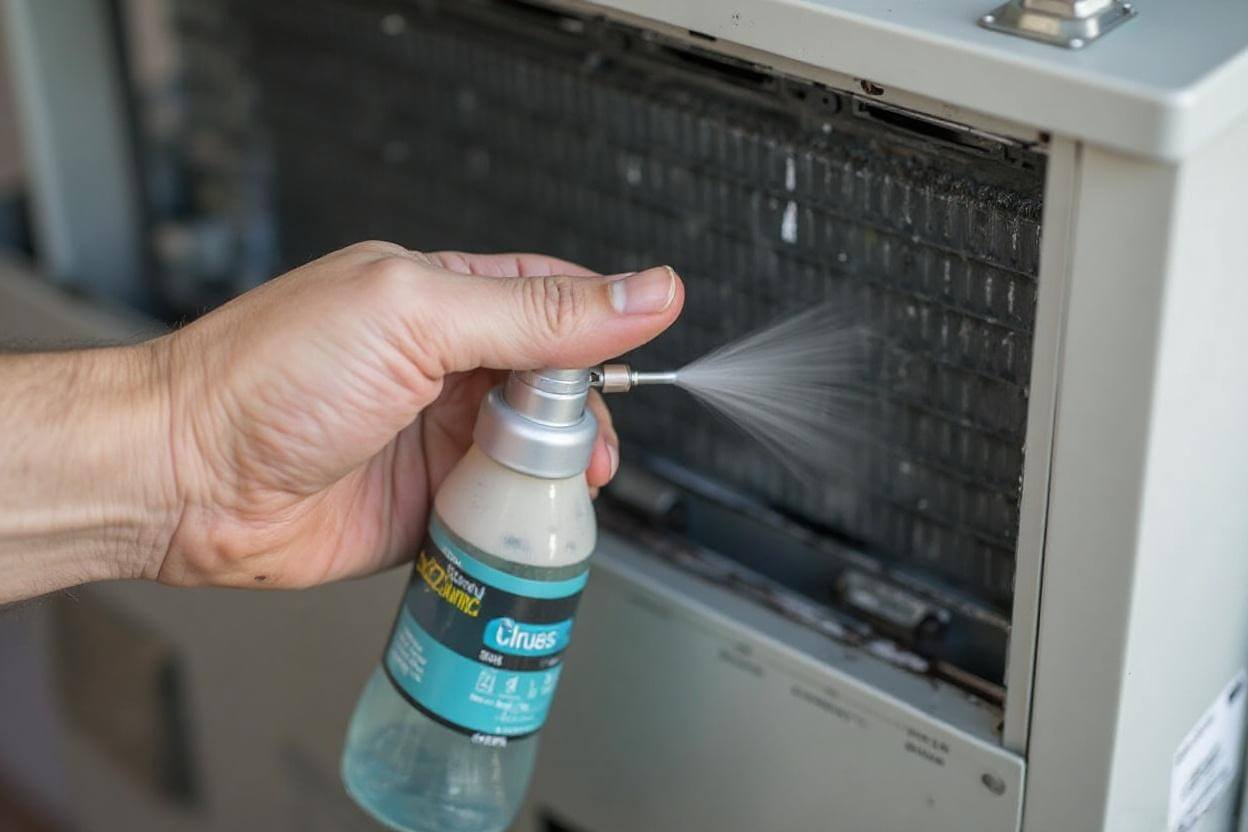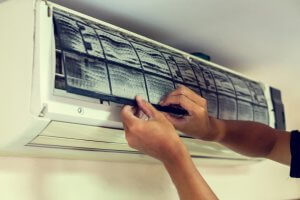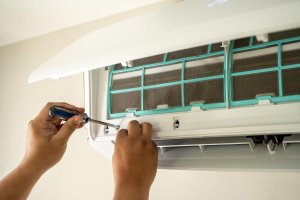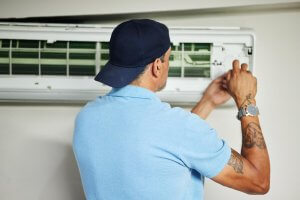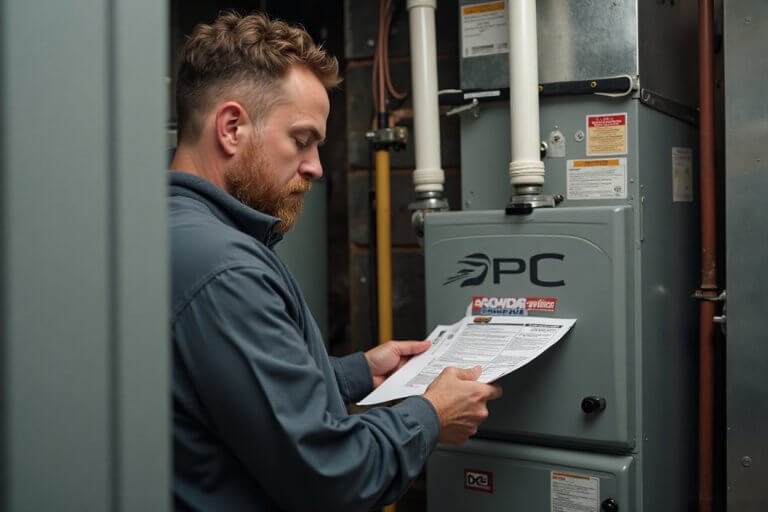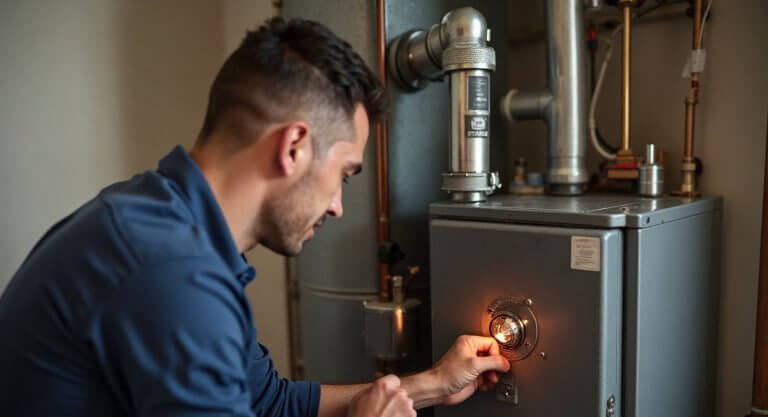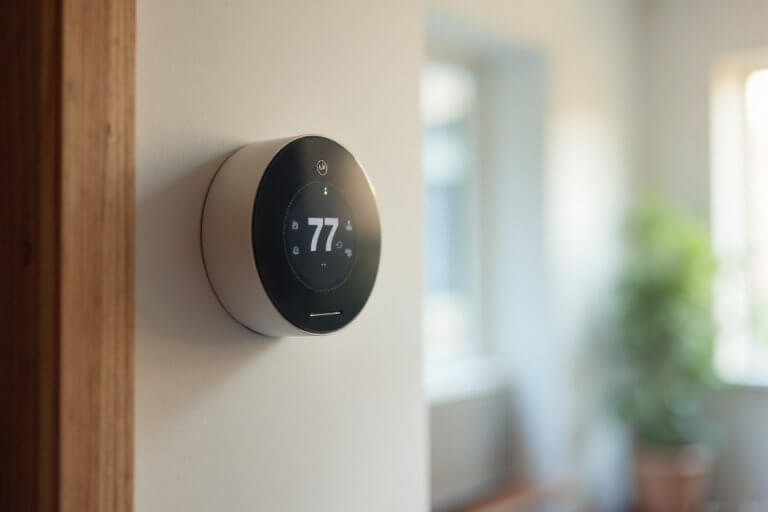If your air conditioner isn’t cooling like it used to, dirty coils might be to blame. Over time, dust, grime, and pet hair can coat your system’s coils, forcing it to work harder just to keep your home comfortable. The result? Higher energy bills, uneven cooling, and more wear on your system. In this guide, you’ll learn how AC coil cleaning works, why it matters, and the safest way to do it yourself.
How to Clean Air Conditioner Coils Safely
To clean air conditioner coils safely, you must follow a clear, step-by-step process.
Here’s how to do it right:
Step 1: Turn off the power at the breaker box
Always shut off your AC unit before cleaning.
Find the breaker box and switch off the circuit for the indoor and outdoor units.
This keeps you safe and protects the system.
Step 2: Remove the access panels
Use a screwdriver to open the panel near your indoor unit.
This gives you access to the evaporator coil.
For outdoor units, open the side panels to reach the condenser coil.
Step 3: Spray the coils with a coil cleaner
Pick a foaming coil cleaner or a no-rinse type that is safe for your unit.
Spray the product evenly across the coil surface using a spray bottle if needed.
Let it sit for 5 to 10 minutes so it can break down dirt.
Step 4: Wipe or rinse the coils
Use a soft brush or cloth to wipe the evaporator coils gently.
For condenser coils, rinse with low-pressure water from a garden hose.
Do not use high pressure. It can bend the coil fins.
Step 5: Let everything dry
Leave the panels open and wait for the coils to dry completely.
You can use a clean towel to speed up drying if needed.
Step 6: Reattach panels and turn the power back on
Secure all panels and make sure everything is closed.
Then return to the breaker box and switch the power back on.
Turn on your thermostat and check that the system is running properly.
Why AC Coil Cleaning Is Critical for Home Performance
AC coil cleaning keeps your system running efficiently and helps it last longer. When your air conditioner kicks on, the coils work to pull heat out of your home. But this cooling process only does its job when the coils are clean.
Over time, they collect dust, dirt, and pet hair. Once that buildup starts, your AC has to run longer just to cool the same space. That burns more energy and puts extra wear on the whole system.
Clogged coils also choke airflow. Rooms feel warmer, humidity rises, and the system begins to struggle. Even key parts like the fan or compressor can wear out faster.
Noticed your energy bills creeping up? Or maybe your system seems to run nonstop?
Dirty coils could be the reason. A simple cleaning can restore airflow, improve comfort, and cut your costs. For many homeowners, it’s one of the easiest ways to protect their HVAC investment.
Cleaning Air Conditioner Components: Don't Forget the Details
After you clean the coils, check a few other parts that help your AC run smoothly.
- Replace the air filter to keep dust out of the evaporator coil
- Rinse the drain line with vinegar to stop clogs or mold
- Wipe the blower fan blades if you see visible dust
- Make sure the area around your unit stays dry and clear
These quick checks take just a few minutes and help prevent new buildup after the cleaning process. Doing them twice a year keeps your system efficient and your air cleaner.
Which AC Coil Cleaner to Use for Indoor and Outdoor Units
The best AC coil cleaner depends on the type of coil and how dirty it is. For indoor evaporator coils, go with a gentle foaming cleaner or a no-rinse spray that’s safe for aluminum. These options break up dust and light mold without using harsh chemicals. If it helps, pour the cleaner into a spray bottle to get even coverage.
Now, for outdoor condenser coils, you’ve got more flexibility. A stronger foam formula works fine here as long as it’s safe for painted or coated metal surfaces.
Always read the label and avoid acid-based products. These may clean faster but can damage the fins or react with coil materials.
Some homeowners make a mild mix of dish soap and warm water. This works for light dirt but won’t remove grease or stuck-on buildup. Never use bleach, oven cleaner, or anything not made for AC coils.
If you’re unsure what to pick, choose a cleaner marked for use on both evaporator and condenser coils. Look for labels that mention compatibility with copper or aluminum, and try to use one that the EPA approves for indoor air safety.
Always do the cleaning process while the system is powered off and coils are cool to the touch. Wear gloves and keep the space ventilated. That way, you clean AC coils without risking damage or spreading fumes.
What Evaporator Coils Do and How to Care for Them
Evaporator coils sit indoors and pull heat out of the air. When your AC kicks on, warm air moves over these chilled coils. The heat gets absorbed, and cooler air is pushed back into your home.
Clean coils do the job best. But over time, they start picking up dust, pet hair, and moisture, especially if your air filter hasn’t been changed in a while. That buildup makes it harder to cool your home and may cause the coil to freeze or smell musty.
You can care for the evaporator coil by changing the air filter every 30 to 60 days. High-quality filters trap more dust and help keep the coil dry. Also, keep the area around your unit clean and free of clutter.
If you notice weak airflow or musty smells, it could mean the coil is dirty. A gentle clean with safe coil cleaners or a visit from a technician can restore performance and prevent mold.
How to Protect Your Condenser Coil from Dirt and Damage
Condenser coils can be protected by keeping the area clear and checking for rust. Trim plants around the unit and don’t let leaves pile up. You can also use a cage or guard to stop pets or kids from damaging the unit.
If your unit is close to a dusty road or garden, check it more often. A yearly clean helps keep it running smoothly.
Need AC Coil Cleaning? We’re Just a Call Away
If your home isn’t cooling like it used to, it might be time for coil cleaning or AC maintenance.. Our certified techs at Season Control take care of everything. We show up on time, treat your system with care, and leave your home cool again. Want to book a service today? Call (818) 275-8487 or click here. Same-day and 24/7 service available.
FAQs
What is an evaporator coil?
An evaporator coil is the part of your AC system that sits inside your home and pulls heat out of the air. When warm air passes over the cold coil, it cools down before circulating through your vents. This cooling step is a big part of your AC’s job and keeps your home comfortable.
How do I know if my coils are dirty?
You can tell your coils are dirty if your AC runs longer than usual or if rooms stay warm even when the system is on. A drop in airflow, musty smells, or higher energy bills are also signs the coils need cleaning. Dirt blocks heat transfer and slows the system down.
Can I clean coils myself?
Yes, you can clean coils yourself if you follow each step carefully. Always turn off the power at the breaker box before starting. Use a soft brush or safe cleaner made for coils. The cleaning process is simple, but it must be done gently to avoid bending or damaging parts.
How often should I clean coils?
You should clean your coils once or twice a year, depending on how often you use the AC. Homes with pets or lots of dust might need more frequent cleaning. Staying on top of the cleaning process keeps your system running smoothly and avoids costly breakdowns.
Why do condenser coils need special attention in outdoor units?
Condenser coils need special care because they sit outside and get dirty fast. These coils release heat from your home, but when they’re covered in dust, leaves, or grass, they can’t work properly. Blocked fins reduce airflow and make your system run longer to cool the same space. To avoid problems, rinse the condenser coils gently with water once a year, or more often if your yard collects a lot of debris.
